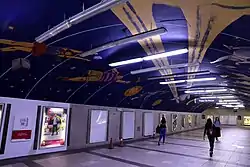Makati pedestrian underpasses
The following article details the pedestrian underpasses of Makati, all of which are in the city's Central Business District (CBD). The underpasses are part of Makati's pedestrian walkway network which consist of underpasses, covered sidewalks, and elevated walkways.
Makati CBD underpasses | |
|---|---|
| Pedestrian underpass network | |
 Paseo De Roxas Underpass | |
| Opening date | 1995 (first underpass) |
| Owner | Makati Commercial Estate Association |
| Location | Makati, Metro Manila, Philippines |
Background
Makati's underpasses were developed jointly by the Ayala Land, and its estate association, Makati Commercial Estates Association (MCEA). The first of these underpasses was the one in Legazpi Street, built in 1995.[1][2] This was a response to the heavy traffic congestion in the 1990s.[3]
The underpasses are also noted for its murals in its interiors.[4][5][6]
Summary
Makati pedestrian underpasses
Key:-
Apartment Ridge
Legazpi
Makati Ave
Paseo De Roxas
Paseo–Villar
Salcedo
Sedeño
V.A. Rufino
1
2
3
4
5
6
7
8
| Underpass | Coordinates | Notes | Ref. |
|---|---|---|---|
| Apartment Ridge Underpass | 14°33′12.2″N 121°01′35.1″E | [7] | |
| Legazpi Underpass | 14°33′18.1″N 121°01′26.0″E | Built in 1995; connects Ayala Triangle Gardens and Ayala Center; has a mural depicting various flora and fauna of the Philippines | [8][9] |
| Makati Ave Underpass | 14°33′16.1″N 121°01′28.1″E | [7] | |
| Paseo De Roxas Underpass | 14°33′24.4″N 121°01′16.6″E | Has a marine biodiversity-themed mural, a project of the Security Bank Foundation Inc. | [10] |
| Paseo–Villar Underpass | 14°33′29.6″N 121°01′30.7″E | Built from 2019–2021; connects the north side of Ayala Triangle Gardens to Salcedo Village. | [11][12] |
| Salcedo Underpass | 14°33′35.8″N 121°00′58.9″E | Features a mural paying homage to local heroes who left a positive impact in their communities. | [7][13] |
| Sedeño Underpass | 14°33′26.8″N 121°01′22.1″E | [8] | |
| V.A. Rufino Underpass | 14°33′30.1″N 121°01′07.9″E | [7] |
References
- Tan, Salvador (December 7, 2019). "Transforming a Business District into Walkable Space with Private Financing". Development Asia. Asian Development Bank. Retrieved November 16, 2021.
- Let's build sustainable communities: 2014 Sustainability Report (PDF). Ayala Land. 2014. p. 26. Archived from the original (PDF) on June 29, 2016. Retrieved November 16, 2021.
In 1995, the first of several pedestrian underpasses and covered sidewalks was constructed when a portion of an existing street (Legazpi) was closed to traffic, paved and landscaped for exclusive pedestrian use, and connected to a pedestrian underpass across Ayala Avenue
- Fulgar, Ar John Ian Lee (October 17, 2021). "The journey of Makati City towards walkability". Philippine Daily Inquirer. Retrieved November 16, 2021.
- "Makati pedestrian underpass ceiling murals stir the imagination, uplift the spirit". GMA News. May 23, 2014. Retrieved November 16, 2021.
- "Pedestrians drive development in Makati". Manila Bulletin. October 23, 2021. Retrieved November 16, 2021.
- "Passing under history". BusinessWorld. February 18, 2020. Retrieved November 16, 2021.
- Sawadjaan, Aliyya (May 18, 2019). "Enhancing pedestrian connectivity in Makati". The Philippine Star. Retrieved November 16, 2021.
- "Art collaboration brightens Makati's pedestrian underpasses". The Manila Times. June 13, 2010. Retrieved November 16, 2021.
- "Pedestrians drive development in Makati". Manila Bulletin. October 23, 2021. Retrieved June 21, 2022.
- Soliman, Michelle Anne (July 10, 2019). "A new mural on marine life decorates the Paseo underpass". Business World. Retrieved June 21, 2022.
- "This new Makati underpass might be the best-looking one in the city". ANCX. October 5, 2021. Retrieved November 16, 2021.
- "LOOK! This new Makati underpass might be the best-looking one in the city". ANCX. Retrieved June 21, 2022.
- Chua, Zsarlene (February 19, 2020). "Passing under history". Business World. Retrieved June 21, 2022.
This article is issued from Wikipedia. The text is licensed under Creative Commons - Attribution - Sharealike. Additional terms may apply for the media files.